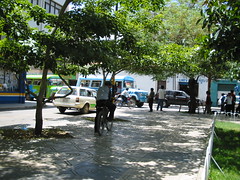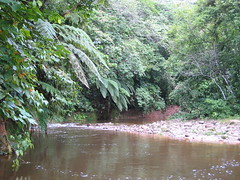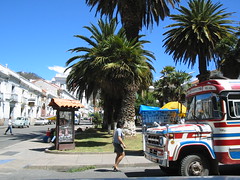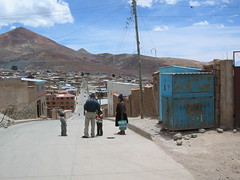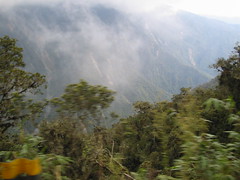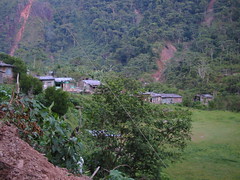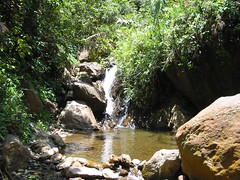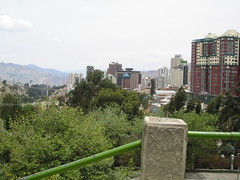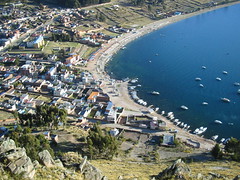After spending a long period in the andean altitude, going down back to the amazon basin is an emotion, not matter if the climate becomes extremely hot and humid. Santa Cruz de la Sierra is located in the middle of the internal Bolivian trades, but also to and from other neighboring Latin American countries (Brazil, Paraguay, Argentina). No surprise that Santa Cruz, without being a city with intense history, is now the economic capital of Bolivia and the final goal of intense internal migration, driven by the search for work. Santa Cruz is already a frontier town in the east direction, because the Brazilian giant is closed and because it shares a strip of land with Paraguay called the Chaco: a sort of Latin American savannah, a sparsely populated and semi-arid area, turning into the Pantanal at the border, thanks to the influx of water from the Paraguay River and tributaries.
This territory is crossed by the oriental express train, a steel serpent that daily connects Santa Cruz to Quijarro, Bolivia’s last piece of land before Brazil.
Cochabamba and Villa Tunari
We listen for hours to the music that comes from the depths of the jungle: all this cosmos of lush greenery, mysterious animals and craftsmen of nature breathe in unison, incessantly. At the edge of this fabulous world lies Villa Tunari. Crossing point between the Andes and the Amazon Basin, between the brown and the green world. It does not surprise that in the pan-amazonian culture the green takes so many nuances, that is identified with different words in the indigenous languages. Over the Chapare river, where the chaotic progress launched its challenge to nature, there is still not a clear winner, but losing such a wealth of energy, culture and harmony would be an unforgivable crime.
And Cochabamba is watching us in disbelief, in its eternal spring above the misty amazon, proud of its fights that made it an example in the world for having firmly established the right to water as a common good.
Sucre, the white capital
Sucre, nicknamed by its inhabitants the white capital of South America, is a city to be observed as a whole, like Potosi. Two places attract positively our attention: the university area, lively and youthful, and the market area, colorful and full of life.
Bolivia is one of the Latin American countries where the people make more extensive use of bloqueos road to demand rights and get listened by the authorities. For this same reason, we have to leave Sucre taking the only road not blocked to traffic in the direction of Oruro with Cochabamba as final destination, on an overnight journey.
Potosi the rich and buen vivir
A long way between La Paz and Potosi, the map deceives: they are more than ten hours by bus through the wildest Bolivian Andean plateau. “I am Potosi, the rich”… Thanks to the largest silver mine in the world, this city has experienced an incredible colonial splendor, in large part still visible because since the hunger for silver is decreased, the time stopped in Potosi. The city is now a fossil of a glittering past, a gem set among the peaks that, given the exaggerated altitude of the Andean plateau, are reduced to mere hills, bare and colorful. The people are friendly and gladly tell the secrets of Potosi: its quiet, its festivals, the hidden beauty, the characters who lived there and the countless numbers of miners who have left their lives chasing the ephemeral wealth in the bowels of the Cerro Rico, in the den of the devil.
It applies well to Potosi the concept of Bolivian buen vivir, a series of propositions and recipes married by the Bolivian people, at least in words, with the vision to ensure a future of consensus and sustainable progress, in harmony with the mother earth and respecting the cultural specificities of Bolivia, a vast and diverse country stretching from the Andes to the Amazon, with a kaleidoscopic wealth of cultures. One of the postulates of living well is to know how to eat well. In Potosi we taste a dish that well summarizes the concept, the k’alaphurka: a delicious soup of tomato, pepper, ají (hot sauce), choclo (young corn), some meat and spices, which is cooked in pumice stone and served in an earthenware dish. A plate of great topicality due to its simple origin and local ingredients.
Coroico and Yungas road towards La Paz
Last part. We leave Santa Rosa, a vicious village of gold miners (we finally understand why these places belong to the gold trail) and we return closed to La Paz going up to the pretty village of Coroico. Here the view embraces the Andean peaks, the Yungas and the Amazon basin. The view is breathtaking.
Finally we take the last and eventful climb to La Paz along the Yungas road (better known as the Death Road or Road of fate), that is the most dangerous road in the world . The small bus limps on the steep slopes, the many intersections with other motor vehicles force us to millimetric maneuvers over the abyss, wrapped in a dark fog. The omens are not the best, but late in the evening we arrive in La Paz, with a wealth of memories and unforgettable experiences.
Gold trail, Incachaca and Santa Rosa
Second part. Our incredible journey continues from Consata and the atmosphere around us becomes more and more friendly. We have built a friendship that can break down the wall of mutual diversity and sometimes mistrust. Admiring the wild beauty of the Yungas, we received some patient lessons of Quechua and Aymara (Inti and Lupi for the word sun), the languages spoken by the indigenous population. We focus on essential concepts such as friends, family, the forest, the mountains, the sky, the sun and the moon.
In the middle of the night, after warmly greeting our friends from Consata, we find a passage to Incachca, on the gold trail in the direction of Santa Rosa. A bumpy trail takes us in the heart of the jungle through a night landscape of incomparable charm. The forest is animated by the sounds of countless living beings, they breathe, sing and dance in unison. We perceive all the immense energy of the Pachamama. With our traveling companions, we reach Incachaca late in the night, where we camp under the stars, but we are so excited that we could not sleep. The jungle prepares us to a magnificient dawn with a crescendo of music tunes. We arrive in Santa Rosa.
Sorata towards the gold route
First part. From La Paz the small and crowded bus rises and falls slowly to Sorata, cozy resort perched on the slopes of Cerro Ancohuma (Janq’u Uma in Aymara). From this plateau begins a furious descent to the Yungas, the area of transition between highlands and the Amazon basin. The fog envelops this enchanted and sometimes spooky world, where sudden chasms open in bottomless valleys.
The village of Consata hides precisely in one of these valleys, where the river of the same name flows. The village received us with great hospitality and we are accompanied by a delegation of young and old along the river for a pleasant and interesting excursion. Here begins the most intriguing and complicated part of our journey to the discovery of the unknown Bolivia.
La Paz of Bolivia
La Paz is a Latin American metropolis, in Bolivian sauce. Nestled between towering Andean peaks, the city is struggling on steep slopes which are memorable for a capital city (the highest in the world with 3,650 meters above sea level), but with the extremes of 4100 meters in El Alto and of 3,000 meters in the suburbs of La Paz. The city center is surrounded by the Cathedral and the Government Palace, or Palacio Quemado, named after the number of times it was burned by the flames. Meeting point for travelers from all over Latin America, La Paz concentrates too many social contrasts: colorful markets give way to modern quarters and then again neglected streets where barter is still practiced and you can live, sleep and eat with little money.
A plane takes off, blinking stars, never so many, never so close, night passengers of rickety buses without a destination. A cable car that combines both worlds. La Paz.
Isla del Sol and Tiwanaku
In the religion of the Incas, it was believed that the sun god was born here. And with reason. The Isla del Sol is beatifully positioned in the Bolivian side of the Lake Titicaca.
Left the Lake Titicaca and Isla del Sol, in the direction of La Paz, the Tiwanaku unesco site lies in the middle of the andean highlands, surrounded by semi-desertic landscape and dominated by some of the highest and most magnificient andean peaks (Janq’u Uma, Illampu, Huayna Potosi, Illimani). The site is worldwide famous for being the inauguration speeches of Evo Morales, in front of the gateway of the sun and for being a highly spiritual place, representing the vision of a world centered on the tradition and matriarcal social footprint of the indigenous peoples.
The dream of Copacabana
Welcome to Bolivia! The dream at the heart of Latin America, a country that has been able to chart a course in history, sinking its roots in the ancient rites of the Pachamama, the mother earth. Bolivia, the land of the indigenous peoples who were able to offer an alternative, a new vision of the relationship between man and nature, man and natural resources. A country that still relies on the popular tradition and the syncretism as a remedy for the pains of daily life. Bolivia A colorful and musical tune with its contrasts, from the peaks of the Andes to the Amazon rainforest.
Tiwanaku is the symbol of the ancient origins of Bolivia, a meeting of diametrically opposed cultures, a meeting between the sun and the moon, where the extreme material poverty has always been balanced by a huge spiritual wealth. On one side the Lake Titicaca, the Isla del Sol and the bolivian Copacabana. On the other side La Paz and the Yungas, coming soon. Bolivia, a hope for all the souths of the world.
